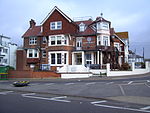Westcliff-on-Sea
EngvarB from December 2013Populated coastal places in EssexSeaside resorts in EnglandSouthend-on-Sea (district)

Westcliff-on-Sea (often abbreviated to Westcliff, and in the past spelt as Westcliffe-on-Sea) is a suburb of the city of Southend-on-Sea, in the ceremonial county of Essex, England. It is on the north shore of the lower Thames Estuary, about 34 miles (55 km) east of London. The Westcliff-on-Sea area is described by Southend-on-Sea City Council as having a border in the east with Milton Road, Hamlet Court Road and Gainsborough Drive; Prittlewell Chase to the North and Valkyrie Road/ London Road/ Southbourne Grove in the west. Traditionally Westcliff included Chalkwell.
Excerpt from the Wikipedia article Westcliff-on-Sea (License: CC BY-SA 3.0, Authors, Images).Westcliff-on-Sea
Lydford Road, Southend-on-Sea Westcliff-on-Sea
Geographical coordinates (GPS) Address Nearby Places Show on map
Geographical coordinates (GPS)
| Latitude | Longitude |
|---|---|
| N 51.5359 ° | E 0.697 ° |
Address
Lydford Road
Lydford Road
SS0 7FF Southend-on-Sea, Westcliff-on-Sea
England, United Kingdom
Open on Google Maps









